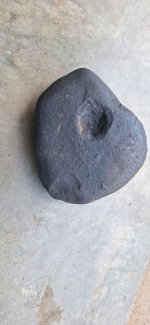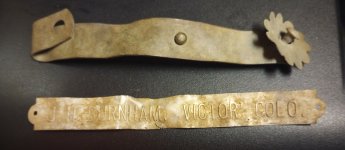Assembler
Silver Member
- May 10, 2017
- 3,105
- 1,186
- Detector(s) used
- Whites, Fisher, Garrett, and Falcon.
- Primary Interest:
- Prospecting
Discovery Vein:
That vein which served as a basis of the location, in contradistinction to secondary, accidental, and incidental veins.
Vein: In mining law. A continuous body of mineral or mineralized rock, filling a seam or fissure in the earth's crust, within defined boundaries in the general mass of the mountain (which boundaries clearly separate it from the neighboring rock), and having a general character of continuity in the direction of its length.
They may refer to the relative importance or value of the different veins, or the relations to each other, or to the time of discovery, but the words "Secondary,"Accidental," and "Incidental" are most frequently used to distinguish between the discovery vein and other veins within the same surface boundaries.
Where the discovery vein crosses the opposite side lines of the claim as located the side lines become end lines, not only with respect to such vein, but for determination of extralateral rights in any other vein which apexes within the claim.
discovery vein
discovery vein
[di′skəv•ə•rē ‚vān]
(mining engineering)
The vein on which a mining claim is based.
https://encyclopedia2.thefreedictionary.com/discovery+vein
Example:
"The discovery of this high-grade vein represents an important new target area that will require additional, closer-spaced drilling in 2018," Erdene said.
Mining Journal - Vein Discovery Stands Out At Bayan Khundii
Vein, Discovery
from Glossaries of BLM Surveying and Mapping Terms (1980)
by U.S. Department of the Interior, Bureau of Land Management
In mining law, that vein which served as a basis of the discovery and location of a mining claim.
https://definedterm.com/vein_discovery
Washington State Code:
Cut, excavation, tunnel or test hole in lieu of discovery shaft.
Any open cut, excavation or tunnel which cuts or exposes a lode and from which a total of two hundred cubic feet of material has been removed or in lieu thereof a test hole drilled on the lode to a minimum depth of twenty feet from the collar, shall hold the lode the same as if a discovery shaft were sunk thereon, and shall be equivalent thereto.
[ 1955 c 357 § 1; 1899 c 45 § 3; RRS § 8624.]
Chapter 78.08 RCW: LOCATION OF MINING CLAIMS
78.08.090
Relocating abandoned claim.
The relocation of a forfeited or abandoned quartz or lode claim shall only be made by sinking a new discovery shaft, or in lieu thereof performing at least an equal amount of development work within the borders of the claim, and fixing new boundaries in the same manner and to the same extent as is required in making a new location, or the relocator may sink the original discovery shaft ten feet deeper than it was at the date of commencement of such relocation, and shall erect new, or make the old monuments the same as originally required; in either case a new location monument shall be erected.
[ 1949 c 12 § 2; 1899 c 45 § 8; RRS § 8629.]
MANNER OF LOCATION
The United States mining laws require that placer claims shall be so located as to embrace legal subdivisions of the public land surveys where the lands have been surveyed, except in cases where the placer deposits are of the “gulch” type, that is, located in or along narrow stream beds or gulches, in which case the claims can be located by metes and bounds so as to conform generally to the shape of the deposit on the surface. Where locations are made by legal subdivisions, the smallest subdivision that can be so located is a square 10-acre tract. Each 10-acre tract must be mineral in character, but only one discovery is necessary to validate the claim.
https://books.google.com/books?pg=R...DE&id=7mc3AQAAMAAJ&ots=mtB2G6m4Ay&output=text
This requirement is intended to apply primarily to placer claims located by metes and bounds and not by legal subdivisions. The meaning of the requirement may be illustrated as follows: One locator can locate 20 acres in a single claim, but such location cannot be of such shape as to have any part thereof outside of a square 40-acre tract. In other words, this means that if a square 40-acre figure were to be superimposed on a 20-acre location, all of the location should fall within the boundaries of the square. Four locators could locate a claim embracing 80 acres, but in order to come within the requirements such location would need to be of such width and length as to fall entirely within the boundaries of two square 40-acre tracts, assuming that such 80-acre figure was superimposed on the location.
When a discovery of mineral in placer form has been made on land that is subject to location, a location should be made promptly in order that others may not make a prior location and thus deprive the prospector of his right to work the deposit. While the United States mining laws give no rights to a locator prior to the time he makes a discovery, it is generally customary for a prospector to make a location on the ground he expects to prospect before prospecting has actually begun. Prior to discovery, a prospector in actual occupation and diligently searching for mineral is a licensee or tenant at will, and no adverse right can be initiated or acquired through a forcible or fraudulent intrusion upon his possession by others, but if his occupancy be relaxed or be merely incidental to something other than a diligent search for mineral, another may acquire a valid right by peaceable entry and compliance with the law.
After discovery has actually been made, the prospector may, if he so desires, make as many locations as are necessary to protect his rights to the deposit, there being no limit placed on the number of mining claims that can be located by an individual or a group of locators, but a discovery must be made on each claim located. The extent of the placer material can often be determined by merely examining the surface- of the ground, but in other instances it may be necessary to excavate test-pits or to drill small test-holes. A satisfactory and economical method of determining the extent of the deposit is by the use of a post-hole auger.
When the extent of the deposit has been ascertained, the claim boundaries should be marked by setting up stakes or erecting monuments at the corners of the claim if the land is unsurveyed. If the land is surveyed and the claim is located by legal subdivisions, the United States mining laws do not require that the corners be staked or monumented. However, some states have laws requiring that the corners of the claims be monumented, regardless of whether the land is surveyed or unsurveyed. At the time of location. a location notice should be posted at a conspicuous place on the claim and such notice should contain the name or names of the locators. the date of location, a statement of the legal subdivisions embraced in the claim, or a description of the claim boundaries by metes and bounds with reference to some corner of an existing survey ‘or to some natural object or permanent monument which can be identified readily.
Mineral in Character and the Ten Acre Rule
(Placer Claims Only)
Each 10-acre subdivision of a placer claim must be mineral in character; if a 10-acre tract is nonmineral in character, it must be excluded from the patent. In McCall v. Andrus, 628 F32d 1185 (9th Cir.1980), cert, denied 450 U.S. 996 (1981), the Ninth Circuit Court of Appeals upheld the ten-acre rule and also the rule that only one discovery is required for a claim, regardless of size.
Distinction between "Discovery" and "Mineral in Character"
A small number of Interior and Federal court cases have distinguished between “discovery" and "mineral in character." Proof of discovery requires a showing of an exposed mineral deposit on the claim, whereas, mineral in character may be proved by geological inference. The marketability test is applied to both discovery and mineral in character. Discovery is the higher standard because lands may be mineral in character but still lack a discovery.
THE LAW OF PLACER MINING CLAIMS - dredgersdigest.com
http://www.treasurenet.com/forums/h..../2014/06/THE-LAW-OF-PLACER-MINING-CLAIMS.pdf
Mineral In Character
Lands where the mineral is ordinarily in sufficient quantity to add to their richness and to justify expenditures for its extraction.
2000
https://thediggings.com/dictionary/mineral-in-character
That vein which served as a basis of the location, in contradistinction to secondary, accidental, and incidental veins.
Vein: In mining law. A continuous body of mineral or mineralized rock, filling a seam or fissure in the earth's crust, within defined boundaries in the general mass of the mountain (which boundaries clearly separate it from the neighboring rock), and having a general character of continuity in the direction of its length.
They may refer to the relative importance or value of the different veins, or the relations to each other, or to the time of discovery, but the words "Secondary,"Accidental," and "Incidental" are most frequently used to distinguish between the discovery vein and other veins within the same surface boundaries.
Where the discovery vein crosses the opposite side lines of the claim as located the side lines become end lines, not only with respect to such vein, but for determination of extralateral rights in any other vein which apexes within the claim.
discovery vein
discovery vein
[di′skəv•ə•rē ‚vān]
(mining engineering)
The vein on which a mining claim is based.
https://encyclopedia2.thefreedictionary.com/discovery+vein
Example:
"The discovery of this high-grade vein represents an important new target area that will require additional, closer-spaced drilling in 2018," Erdene said.
Mining Journal - Vein Discovery Stands Out At Bayan Khundii
Vein, Discovery
from Glossaries of BLM Surveying and Mapping Terms (1980)
by U.S. Department of the Interior, Bureau of Land Management
In mining law, that vein which served as a basis of the discovery and location of a mining claim.
https://definedterm.com/vein_discovery
Washington State Code:
Cut, excavation, tunnel or test hole in lieu of discovery shaft.
Any open cut, excavation or tunnel which cuts or exposes a lode and from which a total of two hundred cubic feet of material has been removed or in lieu thereof a test hole drilled on the lode to a minimum depth of twenty feet from the collar, shall hold the lode the same as if a discovery shaft were sunk thereon, and shall be equivalent thereto.
[ 1955 c 357 § 1; 1899 c 45 § 3; RRS § 8624.]
Chapter 78.08 RCW: LOCATION OF MINING CLAIMS
78.08.090
Relocating abandoned claim.
The relocation of a forfeited or abandoned quartz or lode claim shall only be made by sinking a new discovery shaft, or in lieu thereof performing at least an equal amount of development work within the borders of the claim, and fixing new boundaries in the same manner and to the same extent as is required in making a new location, or the relocator may sink the original discovery shaft ten feet deeper than it was at the date of commencement of such relocation, and shall erect new, or make the old monuments the same as originally required; in either case a new location monument shall be erected.
[ 1949 c 12 § 2; 1899 c 45 § 8; RRS § 8629.]
MANNER OF LOCATION
The United States mining laws require that placer claims shall be so located as to embrace legal subdivisions of the public land surveys where the lands have been surveyed, except in cases where the placer deposits are of the “gulch” type, that is, located in or along narrow stream beds or gulches, in which case the claims can be located by metes and bounds so as to conform generally to the shape of the deposit on the surface. Where locations are made by legal subdivisions, the smallest subdivision that can be so located is a square 10-acre tract. Each 10-acre tract must be mineral in character, but only one discovery is necessary to validate the claim.
https://books.google.com/books?pg=R...DE&id=7mc3AQAAMAAJ&ots=mtB2G6m4Ay&output=text
This requirement is intended to apply primarily to placer claims located by metes and bounds and not by legal subdivisions. The meaning of the requirement may be illustrated as follows: One locator can locate 20 acres in a single claim, but such location cannot be of such shape as to have any part thereof outside of a square 40-acre tract. In other words, this means that if a square 40-acre figure were to be superimposed on a 20-acre location, all of the location should fall within the boundaries of the square. Four locators could locate a claim embracing 80 acres, but in order to come within the requirements such location would need to be of such width and length as to fall entirely within the boundaries of two square 40-acre tracts, assuming that such 80-acre figure was superimposed on the location.
When a discovery of mineral in placer form has been made on land that is subject to location, a location should be made promptly in order that others may not make a prior location and thus deprive the prospector of his right to work the deposit. While the United States mining laws give no rights to a locator prior to the time he makes a discovery, it is generally customary for a prospector to make a location on the ground he expects to prospect before prospecting has actually begun. Prior to discovery, a prospector in actual occupation and diligently searching for mineral is a licensee or tenant at will, and no adverse right can be initiated or acquired through a forcible or fraudulent intrusion upon his possession by others, but if his occupancy be relaxed or be merely incidental to something other than a diligent search for mineral, another may acquire a valid right by peaceable entry and compliance with the law.
After discovery has actually been made, the prospector may, if he so desires, make as many locations as are necessary to protect his rights to the deposit, there being no limit placed on the number of mining claims that can be located by an individual or a group of locators, but a discovery must be made on each claim located. The extent of the placer material can often be determined by merely examining the surface- of the ground, but in other instances it may be necessary to excavate test-pits or to drill small test-holes. A satisfactory and economical method of determining the extent of the deposit is by the use of a post-hole auger.
When the extent of the deposit has been ascertained, the claim boundaries should be marked by setting up stakes or erecting monuments at the corners of the claim if the land is unsurveyed. If the land is surveyed and the claim is located by legal subdivisions, the United States mining laws do not require that the corners be staked or monumented. However, some states have laws requiring that the corners of the claims be monumented, regardless of whether the land is surveyed or unsurveyed. At the time of location. a location notice should be posted at a conspicuous place on the claim and such notice should contain the name or names of the locators. the date of location, a statement of the legal subdivisions embraced in the claim, or a description of the claim boundaries by metes and bounds with reference to some corner of an existing survey ‘or to some natural object or permanent monument which can be identified readily.
Mineral in Character and the Ten Acre Rule
(Placer Claims Only)
Each 10-acre subdivision of a placer claim must be mineral in character; if a 10-acre tract is nonmineral in character, it must be excluded from the patent. In McCall v. Andrus, 628 F32d 1185 (9th Cir.1980), cert, denied 450 U.S. 996 (1981), the Ninth Circuit Court of Appeals upheld the ten-acre rule and also the rule that only one discovery is required for a claim, regardless of size.
Distinction between "Discovery" and "Mineral in Character"
A small number of Interior and Federal court cases have distinguished between “discovery" and "mineral in character." Proof of discovery requires a showing of an exposed mineral deposit on the claim, whereas, mineral in character may be proved by geological inference. The marketability test is applied to both discovery and mineral in character. Discovery is the higher standard because lands may be mineral in character but still lack a discovery.
THE LAW OF PLACER MINING CLAIMS - dredgersdigest.com
http://www.treasurenet.com/forums/h..../2014/06/THE-LAW-OF-PLACER-MINING-CLAIMS.pdf
Mineral In Character
Lands where the mineral is ordinarily in sufficient quantity to add to their richness and to justify expenditures for its extraction.
2000
https://thediggings.com/dictionary/mineral-in-character
Last edited:






